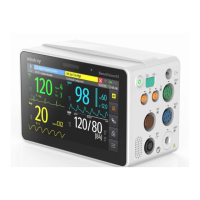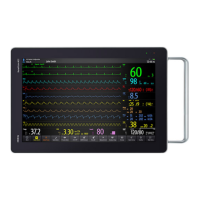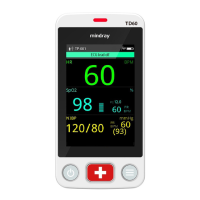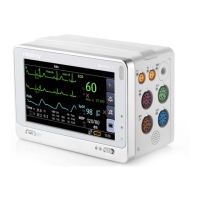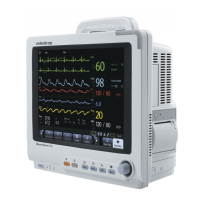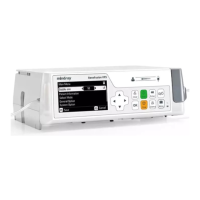A - 12 BeneVision N Series Patient Monitor Operator’s Manual
Pace pulse markers Pace pulses meeting the following conditions are labelled with a PACE marker:
Amplitude:
Width:
Rise time:
No overshoot
±2 to ±700 mV
0.1 to 2 ms
10 to 100 s (no greater than 10% of pulse
width)
Pace pulse rejection When tested in accordance with the IEC 60601-2-27: 201.12.1.101.13, the
heart rate meter rejects all pulses meeting the following conditions.
Amplitude:
Width:
Rise time:
No overshoot
±2 to ±700 mV
0.1 to 2 ms
10 to 100 s (no greater than 10% of pulse
width)
HR
Measurement range Neonate: 15 to 350 bpm
Pediatric: 15 to 350 bpm
Adult: 15 to 300 bpm
Resolution 1 bpm
Accuracy ±1 bpm or ±1%, whichever is greater.
Sensitivity 200 V (lead II)
HR averaging method In compliance with the requirements in Clause 201.7.9.2.9.101 b) 3) of IEC
60601-2-27, the following method is used:
If the last 3 consecutive RR intervals are greater than 1200 ms, the 4 most
recent RR intervals are averaged to compute the HR. Otherwise, heart rate is
computed by subtracting the maximum and minimum ones from the most
recent 12 RR intervals and then averaging them.
The HR value displayed on the monitor screen is updated no more than one
second.
Response to irregular rhythm In compliance with the requirements in Clause 201.7.9.2.9.101 b) 4) of IEC
60601-2-27, the heart rate after 20 seconds of stabilization is displayed as
follows:
Ventricular bigeminy (waveform A1): 80±1 bpm
Slow alternating ventricular bigeminy (waveform A2): 60±1 bpm
Rapid alternating ventricular bigeminy (waveform A3): 120±1 bpm
Bidirectional systoles (waveform A4): 90±2 bpm
Response time to heart rate change Meets the requirements of IEC 60601-2-27: Clause 201.7.9.2.9.101 b) 5).
From 80 to 120 bpm: less than 11 s
From 80 to 40 bpm: less than 11 s
Time to alarm for tachycardia Meets the requirements in Clause 201.7.9.2.9.101 b) 6) of IEC 60601-2-27.
Waveform
B1h-range:
B1-range:
B1d-range:
B2h-range:
B2-range:
B2d-range:
<11 s
<11 s
<11 s
<11 s
<11 s
<11 s
Tall T-wave rejection capability When the test is performed based on Clause 201.12.1.101.17 of IEC 60601-2-
27, the heart rate calculation is not affected for QRS of 1 mV amplitude and
100 ms duration, T-wave duration of 180 ms and amplitude lower than 1.2
mV, and QT interval of 350 ms.
Arrhythmia Analysis Classifications Asystole, V-Fib/V-Tac, V-tac, Vent-. Brady, Extreme Tachy, Extreme Brady, Vent
Rhythm, PVCs/min, Pauses/min, Couplet, Bigeminy, Trigeminy, R on T, Run
PVCs, PVC, Tachy, Brady, Missed Beat, Pacer Not Paceing, Pacer Not Capture,
Multiform PVC, Nonsus. V-Tac, Pause, Irr. Rhythm., A-Fib

